WHAT WE LEARNED ❘ By Michael Greco
Hasbrouck Heights, New Jersey, is primarily a residential community sitting roughly 10 miles northwest of midtown Manhattan, just across the Hudson River in Bergen County. The Hasbrouck Heights Fire Department, a volunteer organization, provides fire and EMS services to Hasbrouck Heights and Teterboro, a neighboring town. The department was organized in 1896 and has been serving the residents for more than a century.
- It’s NOT Just Another Vehicle Fire!
- The Officer’s Guide to Preparing for and Commanding Large Vehicle Fires
- Vehicle Fires: Is It Time to Change Our Training?
- Managing Vehicle Fires Safely
Although the area is typical of many suburban communities sitting just outside of New York City, the town has two heavily traveled state highways running through it, Routes 17 and 46. These two highways are major thoroughfares that transport daily commuters and tractor trailer loads of goods 24/7. Over the years, the department has responded to numerous serious vehicle accidents and fires on both highways. Luckily, these instances have provided some experience for the members and are often drilled on or discussed among the membership. In the early morning hours of January 8, 2024, another major incident unfolded.
The Incident
Just before sunrise on a cold winter morning, at approximately 0530 hours, the Hasbrouck Heights Fire Department was dispatched for a report of a working truck fire on Route 17. At the reported location, the highway is six lanes, three in each direction, with a concrete Jersey barrier separating the northbound and southbound lanes. Responding in as chief of department, I was met with smoke already lingering in the street and could see a huge glow in the sky.
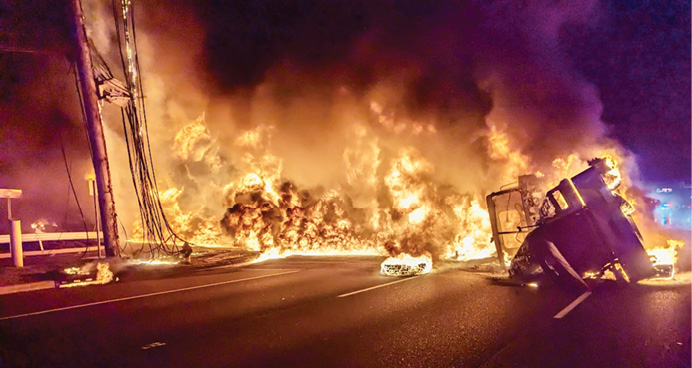

1. & 2. On arrival, the huge fireball from the gasoline tanker fire with a commercial building fully involved. (Photos 1-3 by Justin Derevyanik.)
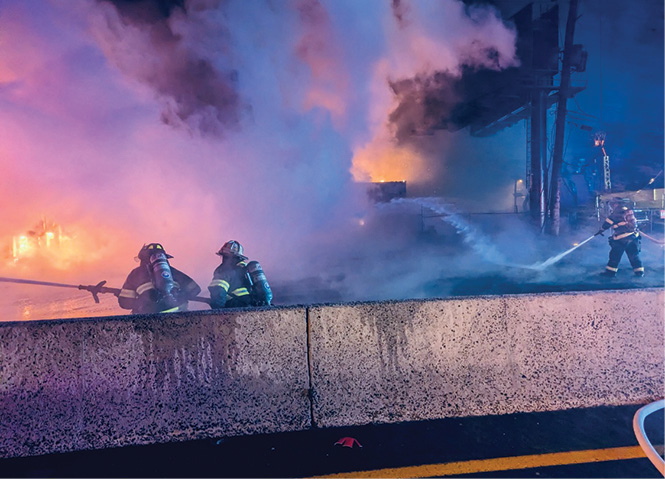
3. Firefighters used handlines to extinguish smaller pockets of fire.
One of my initial thoughts was to call for assistance and get it on the road; if it wasn’t needed, it could always be turned around. In addition, at this time of the morning, I was concerned about how many volunteers might have already left for work or would be unavailable to respond to the call. With these thoughts in my head, I immediately transmitted a 10-30 signal (two engines, one ladder, one rescue, and one ambulance from a nearby medical center), which indicates and all-hands assignment. As I got more information over the radio, I requested an additional engine and ladder.
Approaching the scene, you could see a huge fireball engulfing most of the highway and surrounding area. Getting a good size-up of the situation was difficult due to the brightness of the 100-foot flames and the volume of fire engulfing the immediate area. On arrival, we determined that the reported truck on fire was a gasoline tanker, which was on its side and had already ruptured, spilling its contents and exploding into a ball of fire. Unfortunately, the trailer’s tank had already been severely compromised by fire, and any Department of Transportation (DOT) placards were already burned away.
The fire had also already spread to and engulfed a one-story 50- × 200-foot building of ordinary construction as well as 26 motor vehicles in the building’s parking lot. It also melted the power lines running alongside the highway and dropped them to the roadway below. Some even fell on the fire hydrant that was directly in front of the incident and on fire. I requested a utility company response, but during the early stages of the fire, many of the wires were burning and melting away due to the intensity of the flames.
As I drove by the scene on the opposite side of the highway to get a full view of the incident, my chief’s vehicle’s mirror began to off-gas and melt. In addition, due to the intensity of the fire and huge plume of smoke being generated, nearby Teterboro Airport shut down its runway. I also made an urgent request to dispatch to contact New Jersey Transit and have all passenger railway service shut down because the train tracks literally abutted the incident scene.
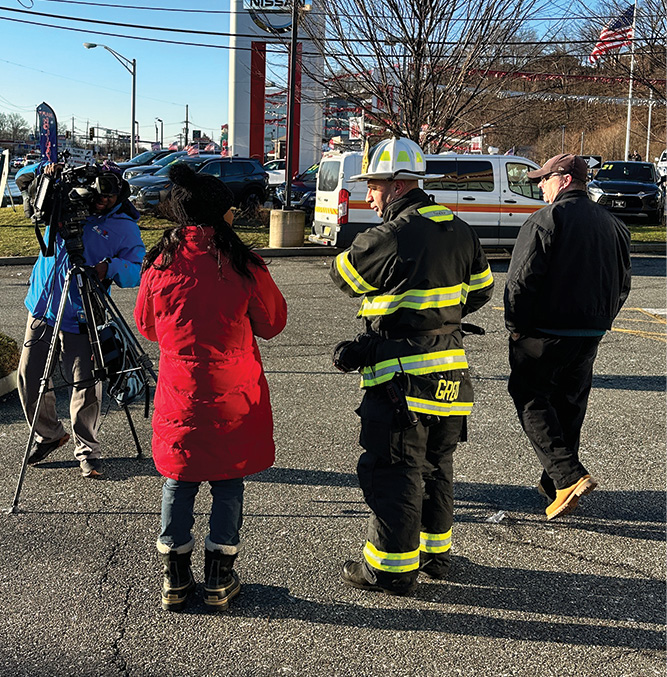
4. The press was kept in a safe staging area and informed by authorized personnel when the fire was under control. (Photos 4-11 by Tony Greco.)
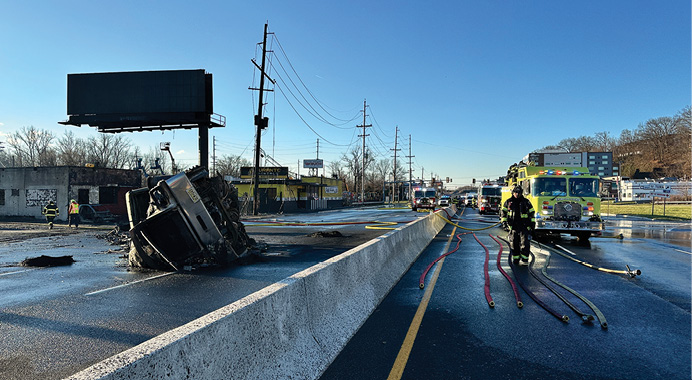
5. The first-due engine took cover behind the concrete divider on the opposite side of the highway and immediately went into a deck gun attack.
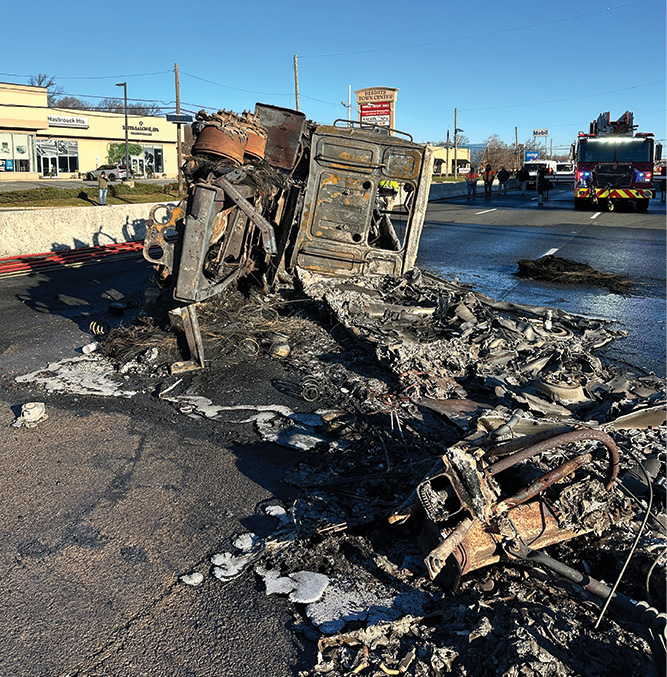
6. The remains of the tanker.
Firefighting Tactics
One of the first concerns was where to set up the command post. An area upwind and uphill was the logical choice and was approximately 200 feet away from the incident out of the radiant heat. As the first-due engine was approaching the scene, I ordered the crew to secure a water source and lay a supply line in so they could operate their deck gun on the abundant amount of fire.
We didn’t initiate a foam operation because we couldn’t supply an entire operation due to the complex nature of this call. Thus, I immediately requested a foam task force response from the Bergen County USAR, which responds from the nearby Teaneck (NJ) Fire Department.
Since the scene was so large, when more chiefs arrived, I put an operations chief at the front and at the rear of the fire area. The first safety officer on scene ensured all members were in full personal protective equipment due to the severity of the fire and its heat.
Once the first-due engine secured a water source from a hydrant 200 feet away, they operated under the direction of an operations chief. Initially, they put their deck gun into service and focused on the main body of fire—the tanker. As they worked on that, their stream was redirected onto both exposures, which were about 50 to 75 feet away. The north exposure, a six- story self-storage warehouse, already had indications of being affected: There was steam coming off its siding and the company sign and outside lighting were already starting to melt. Then the stream was directed back to the tanker and then onto the south exposure, the fully involved building.
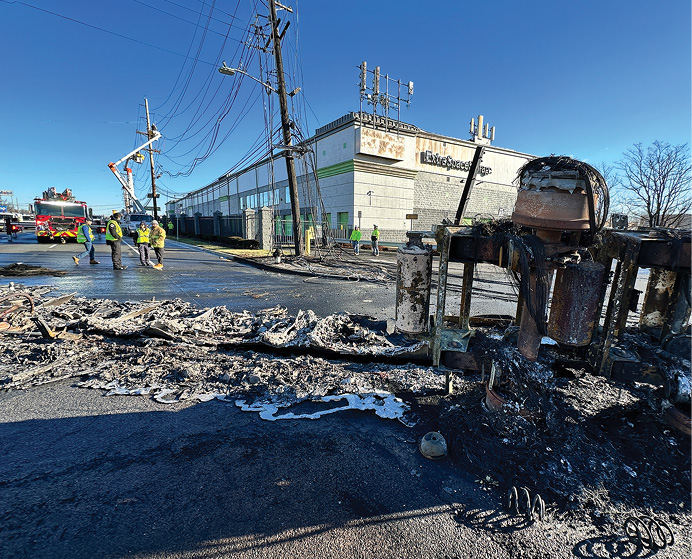
7. One exposure, a self-storage facility, narrowly escaped significant damage because of aggressive extinguishment tactics. Note the burn marks on the signage.
The deck gun was making good headway and was also directed onto some of the burning automobiles in the yard. The deck gun was pumped at 80 pounds per square inch (psi) off a hydrant that provided 120 psi to ensure length of stream and heavy penetration with a 1¾-inch tip. Luckily, a 36-inch water main runs along the highway and has provided ample water over the years. As these operations were in full swing, the building’s roof suddenly collapsed. I conducted a personnel accountability report (PAR); all members were accounted for.
As mutual-aid companies began arriving, the need for more water, fire attack, and protection of the exposures was clearly evident. Even though we were operating off a large water main, I directed one of the incoming chiefs to be the water supply officer, who coordinated those efforts with a Department of Water representative who responded to the scene. The secondary hydrant was well over 800 feet away and also provided a good water source.
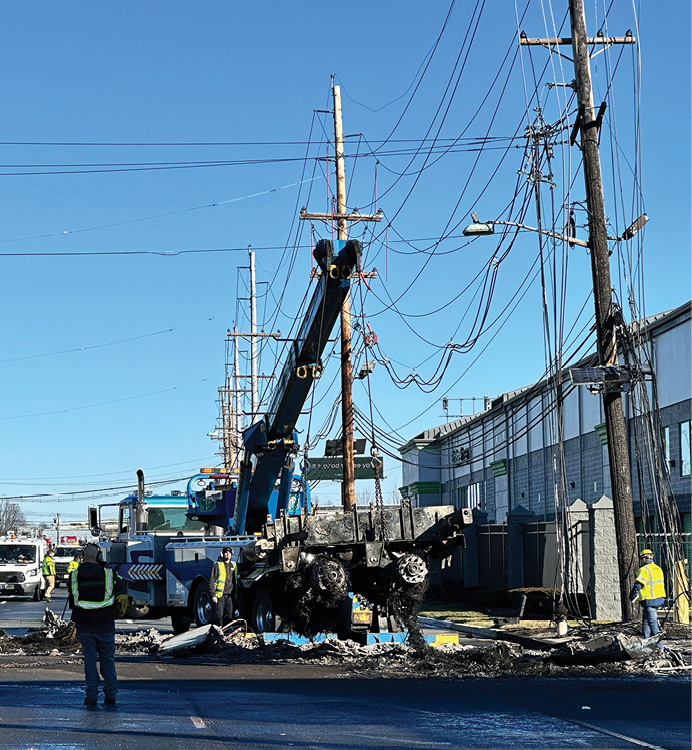
8. Master streams were applied by three aerial ladders.
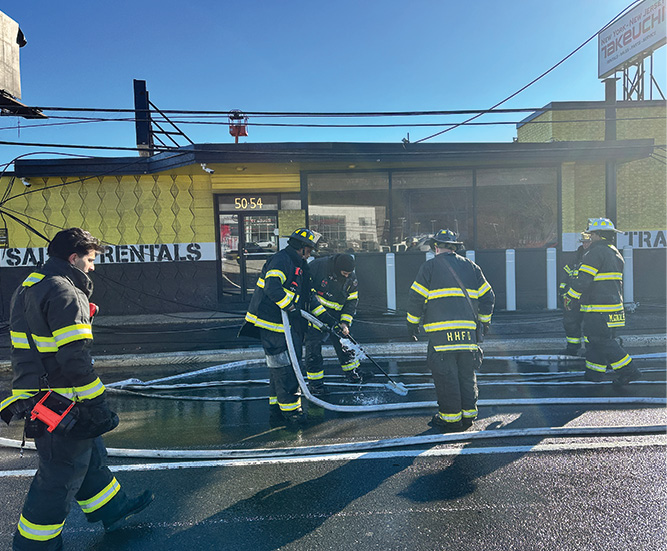
9. Cleanup involving decontamination.
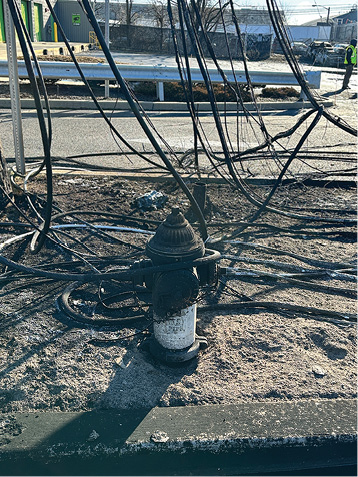
10. The nearest hydrant to the fire scene was surrounded by fire and down wires, making it unusable.
Units attacked the 26 vehicles in the parking lot, protected exposures, attacked the tanker fire, and assisted with extinguishment of the original fire building. This was accomplished with three aerial ladder master streams, one tower ladder stream, two multiversal appliances, and four 2½-inch handlines. Each master stream was in a flanking position and all apparatus were parked uphill and away from the fire. The tower ladder’s stream was focused on the rear of the fire area, which protected nearby woods and the train tracks, where a train had stopped just prior to the fire area.
The fire went to a fourth alarm, but the majority of the fire was knocked down by the first-due engine, which was remarkable considering foam was not used and the task force was not yet on scene. Just a single deck gun with an adequate water supply was able to make a huge impact at this incident. As all the units operated in conjunction with each other, the fire was deemed under control. Unfortunately, there was still a small fire in the collapsed building being fed by natural gas, requiring units to operate there. The surrounding area was being cooled down until the arrival of the gas company, which located a shutoff in the street and shut down the supply.
As the radiant heat subsided and the fire was knocked down, the Bergen County Hazardous Material Team, in conjunction with other agencies, ensured the proper diking and cleanup of any hazardous waste. Early in the operation, with the intensity of the fire and large footprint of the scene, the materials weren’t a priority. These operations had to stand by until the scene was safe to clean up.

11. Burned-out vehicles in the exposure building’s parking lot had to be searched and researched for any victims.
Lessons Learned and Reinforced
- Do not discount the value of the prepiped deck gun, especially when you have a good water source. It does the work of numerous firefighters and is a great asset that is often overlooked in heavy fire situations. Master streams are vital. As the saying goes, “Big Fire, Big Water.”
- In a situation like this, do not commit firefighters or allow them to operate in an area that may have pooling, leaking, or traveling fluids and chemicals, including gasoline. They must use the reach of the hoseline’s stream to protect themselves from radiant heat or a sudden flare-up of fire conditions.
- It is important for the incident commander (IC) to remain calm during an incident of this magnitude. Take deep breaths and watch your tone of voice, speak clearly, don’t whisper, and give direct orders over the radio. It will help keep your firefighters calm and more in tune to what their orders are.
- Aggressive interior search operations are a core value of a fire department. Our department recently rescued a civilian at a fire performing a search before water was applied to the fire. However, at this incident, due to the intensity, size, and scope of the fire, it was not feasible to conduct a search in the fully involved building.
- If you are the IC, you are in charge, and the ultimate liability is on you. Operating on a fireground channel allows you to focus on the fire. Another officer can monitor the dispatch channel for incoming units or requests. Ensure you have help at the command post to process this information, make a schematic drawing, and keep tabs of the mutual-aid units arriving and delegation of their duties. At this incident, the DOT Guidebook was used as a reference, and another officer was in charge of providing that research.
- A command board is a viable tool to have and can allow you to quickly jot down information and check off tactics or requests made. In our area, a county mutual-aid coordinator responds to a second-alarm fire to keep the IC abreast of the next available units that will be coming in on any additional alarms.
- Update your dispatch with progress reports or changing fireground events. Make sure dispatch has the ability to know what is going on to preplan if additional units and resources will be needed on scene or to backfill firehouses. Also, when radio transmissions are recorded, they can be reviewed and used for future critiques and training.
- Account for all members with personal accountability tags at the command post. Radios can and will fail; have at least two backup portable radios. Keep people who are not pertinent to the command post away and do not respond to them. Public information officers can handle news media requests. Pay attention to your members, reports from the operation chiefs, and the fire, which is your top priority.
- If you think your fire is a greater alarm, then call for it. Remember reflex time or if a volunteer organization will be able to respond to the mutual-aid request. It’s always easier to cancel additional resources than it is to wait for their arrival on scene.
- Work with the police department to control traffic, and do not hesitate to shut down an entire highway for safety. Civilians don’t want to get caught in a traffic standstill and will drive into the fire area to avoid being stuck; expect it!
- We conducted a critique immediately after the fire and used the radio transmissions as a source of learning material. A regional critique will be conducted with the responding units so we can learn and improve on mutual-aid response. A large incident like this may not happen often, but the lessons learned and reinforced will help in future incidents.
Luckily, there were no fatalities of any civilians or the gasoline tanker’s driver. There were also no firefighter injuries, mainly due to safe, aggressive, and smart tactics supervised by the safety officer. When faced with a scene of such magnitude, it’s very important to conduct a proper size-up, implement the tactics, then control the pace to avoid a catastrophe.
Michael Greco is chief of the Hasbrouck Heights (NJ) Volunteer Fire Department and a career firefighter in the Hackensack (NJ) Fire Department, where he is the chauffeur of Ladder Company 1. He is a hands-on instructor at FDIC International.

